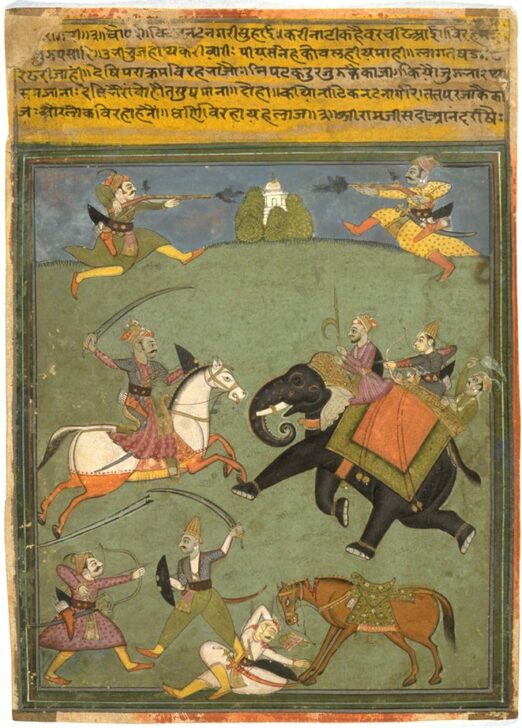Ragamala series: Nata Ragini 3 (Battle scene)
Artist Unknown, India, Rajasthan, Jaipur School

Description
Paintings of the Nata ragini usually depict a battle scene in which the heroine defeats Viraha, who personifies the separation of lovers. Lady Nata is one of the wives of Bhairava raga. Here she is seen on elephant back, her elephant driver in front and a manservant behind, about to loose an arrow at her adversary.
As in the other ragamalas from this set, this painting is inscribed with two poems. The shorter poem may be rendered as:
The lady Nata performed a miraculous deed and was ever alert to carry out the wishes of her master [Bhairava]. She defeated Viraha in battle and he is exceedingly ashamed of his defeat.
Exhibited in "Divine Encounters, Earthly Pleasures: Twenty Centuries of Indian Art," 12/12/03-2/22/04.
Subject Matter:
Ragamala paintings draw from aspects of human experience in order to visualize specific moods, emotions, and qualities such as love, anguish, valor, weakness, and strength. A raga in Indian music is a melody consisting of a string of notes in a particular arrangement. Raginis are derivations from or variations of ragas in feminine mode (the basis of these classifications remains unexplained in many cases), and could have different or similar musical structures as ragas. Specific ragas are associated with specific times of the day, seasons, and emotions. When visualized, as here, ragas and raginis are meant to evoke the same affective responses that are allied to their musical modes. The text above the illustration refers to stories or incidents associated with the depicted raga/ ragini, but may not necessarily be narrative-like or descriptive. Drawn from literary tropes and tales that sophisticated writers and viewers would be aware of, the inscriptions are an integral part of the overall experience of this miniature painting. An illiterate viewer, however, could still enjoy the scene without reading the text.
Paintings of the Nata ragini usually depict a battle scene in which the heroine defeats Viraha, who personifies the separation of lovers. Lady Nata is one of the wives of Bhairava raga. Here she is seen on elephant back, her elephant driver in front and a manservant behind, about to loose an arrow at her adversary.
As in the other ragamalas from this set, this painting is inscribed with two poems. The shorter poem may be rendered as:
The lady Nata performed a miraculous deed and was ever alert to carry out the wishes of her master [Bhairava]. She defeated Viraha in battle and he is exceedingly ashamed of his defeat.
Physical Description:
A battle scene with a number of figures painted on different planes. Horses, elephants, swords, shields, guns, and an injured man populate the image. The scene is intense--a figure is shown as stepping on the body of the maimed fighter in the bottom-center of the image. The stances and gestures overall register movement and action.
Usage Rights:
If you are interested in using an image for a publication, please visit https://umma.umich.edu/request-image/ for more information and to fill out the online Image Rights and Reproductions Request Form.